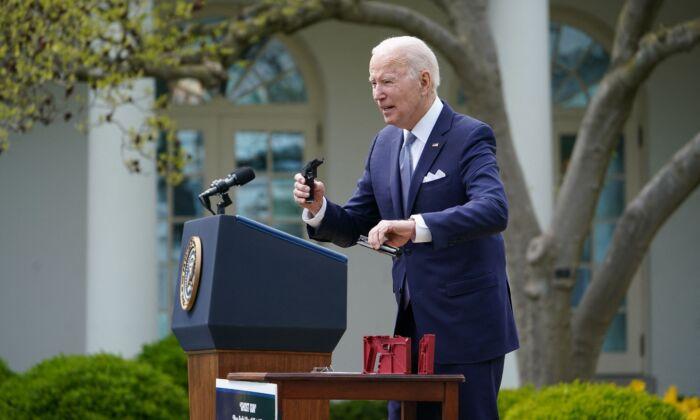Gun control proponents, the Bureau of Alcohol, Tobacco, Firearms and Explosives (ATF), and President Joe Biden say privately made firearms (PMFs), so-called “Ghost Guns,” must be more tightly regulated if law enforcement is going to control crime involving guns.
“It is probable that current trace data significantly underrepresents the number of PMFs recovered in crimes by LEAs due to a variety of challenges presented by PMFs,” ATF spokesperson Kristina Mastropasqua, wrote in an Aug. 23 email to The Epoch Times.
An attorney with the Mountain State’s Legal Foundation, suing the government over its “frame or receiver rule” that treats certain gun parts like firearms, disagrees.
“All the data shows the 80-percent receivers and privately made firearms are not the problem,” Brian Abbas told The Epoch Times on Aug. 21.
This means that specific components must have serial numbers and that their transfer must be handled by a Federal Firearms License holder requiring purchasers to undergo a background check.
According to information from the ATF, the number of PMFs reported by law enforcement agencies increased by 1,083 percent, from 1,629 in 2017 to 19,273 in 2021. This increase may be due to a number of factors, Ms. Mastropasqua wrote.
“PMFs involvement in crime is an emerging issue and LEAs are just beginning to institute uniform training on the recognition, identification, and reporting of PMFs that can lead to more accurate PMF data being collected,” she wrote.
According to Ms. Mastropasqua this is evidence of the danger posed by the homemade guns.
“PMFs by their nature may have no markings, duplicative markings, counterfeit markings, or markings that appear to be serial numbers on parts of the firearm other than the frame or receiver.
“These markings can be mistaken for authentic serial numbers causing law enforcement to not recognize the firearm as a PMF and potentially follow false leads based,” her email reads.
President Biden and other officials have cited this figure in promoting the rule.

During a speech on April 22, 2023, President Biden called PMFs the “gun of choice” for criminals.
“The dramatic rise in trace submissions involving PMFs reflects both increased criminal use of these firearms and enhanced awareness among law enforcement that ATF will process trace requests for PMFs,” the report reads.
Mr. Abbas said the increase in trace requests doesn’t automatically mean increased crime.
Not Necessarily A Crime Gun
“A trace is to determine how firearms wind up in the hands of criminals. Just because it was traced doesn’t mean it was used in a crime,” Mr. Abbas said.He also pointed out that the ATF doesn’t define a “crime gun.” He said a crime gun could be a gun discarded in a trash can behind a grocery store, a rifle used in a murder, a revolver in the glove box of a car owned by a man charged with drunk driving, or a pistol with the serial number obscured.
“Do they suspect it’s a crime gun simply because it doesn’t have a serial number?” he asked.
According to Ms. Mastropasqua, the definition of “crime gun” depends largely on the LEA requesting the trace.
“Crime gun tracing begins when a law enforcement agency recovers a firearm in a criminal investigation and seeks to determine the origin or background of that crime gun as part of the investigative process,” she wrote.
“Every PMF that has been recovered and traced was used in a crime. ATF only traces firearms used in crimes. ”
The rule is currently the subject of a lawsuit in which Mr. Abbas’s organization represents some of the plaintiffs in the case, VanDerStok v. Garland. Earlier this month, the U.S. Supreme Court decided that the rule would remain in effect while the lawsuit makes its way through the courts.
Criminals Ignore the Law
Mr. Abbas, like many other gun rights advocates, counters that criminals are unlikely to change how they obtain guns since, as a rule, they don’t obey the law.Using data from 2016, the most recent year for which data is available, the report shows that 21 percent, an estimated 247,400, of state and federal prisoners, possessed or carried a gun during the crime they were incarcerated.
The report shows that 13 percent of all prisoners had used a firearm by showing, pointing, or discharging it during the offense for which they were imprisoned.
Less than 2 percent of the prisoners purchased their guns through retail outlets.
More than half, 56 percent, obtained their guns illegally.
Most Crime Guns Stolen
The majority of the remainder, about 25 percent, obtained them from friends or family as a loan or gift.“The vast majority of crime guns are going to be stolen firearms,” Mr. Abbas said. “That’s just the way it is.”
The ATF’s report appears to concede the point.
“Instead, prohibited persons determined to get crime guns acquire them through underground crime gun markets that involved unregulated transactions with acquaintances and illicit ‘street’ sources,” the ATF report reads.
Ultimately, Mr. Abbas said the rule would do nothing to prevent crime or make anyone safer.
“All it does is place onerous restrictions on citizens who aren’t going to commit crimes anyway,” he said.
Many Second Amendment advocates believe the government’s motive is building a database of gun owners.
Mr. Abbas said they might have a point. He said there are many ways to trace a firearm that doesn’t require more regulations on law-abiding gun owners.
Fingerprints, DNA, ballistic data, and other physical traits can be used to connect a gun with a crime.
“I think it is all about building a registry,” Mr. Abbas said.
Ms. Mastropasqua disagrees. She pointed out that the ATF is prohibited by law from developing a gun registry and denies that it has done so.
“ATF does not and never has run a gun registry,” she wrote in her email.







